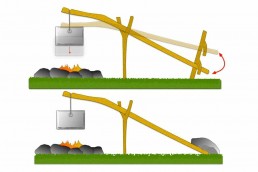The Oldest Multi-tool
SHARE THIS POST
The stick: a fundamental tool that has been passed down through thousands of years and is still being used around our campsites today. It serves as the main component of most shelter frameworks, either as a crossbeam, center pole or wall stringers. It’s a fishing pole, a walking stick, and is used to stir up the coals—or make coals in the first place.
I started thinking about all the uses of this classic outdoor tool and thought I’d share with you some of those utilitarian functions that sticks can serve, from a backcountry spike camp to a modern state park campsite.
Most modern tents are basically freestanding, supported by tension frames that offer fullness and shape without a lot of extended guy-lines. However, sometimes the lines that extend the awning or side flaps over window vents have no close attachment points for the desired opening angle—short of tying off on a distant tree or staking it halfway across your campsite.
A “Y” stick can give you the angle you need with a much shorter staking distance. It works like the old-fashioned clothesline poles used to pitch up the laundry to dry. You can use them to change the roof angle on a dining tarp without having to re-tie the guy-lines as the sun changes angles or the wind blows the rain from another direction.
Sticks have always been used in the hunt for food, first as clubs, later as spears, and eventually as bow and arrows. Even today, a competent, self-reliant hunter can use different forms of spears, made from bigger, longer “sticks” to catch/kill prey. There are several variations on the spear that can be used to pin or kill anything you can get within reach of—in the water or on land. From a simple pointed and heat-hardened spear point, to the more elaborate barb-lined spreading jaw version, these can be made with a split-end shaft and a pocket knife.
I think every Boy Scout knows about making a “Y” stick pot hanger over a campfire. That, and a Dutch oven suspended under a tripod, is etched in every camper’s memory. Using a stick to suspend a pot over the fire from the sidelines can be further enhanced by counter-balancing with a large rock or another, carefully selected stick, with extra branch hooks in the right places.
Some self-reliance tips use a stick as part of the process. One way to sterilize water for drinking is to boil it, a task hard to accomplish if you don’t have a vessel in which to heat the water over a fire. One method to bring water to that critical temperature is to heat rocks and drop them into the container of water you want to treat. That can be accomplished by using a “Y” stick and straight stick together, to form tongs to grasp the hot rocks from the fire.
Are you enjoying this post?
You can be among the first to get the latest info on where to go, what to use and how to use it!
Such tongs can also grab a slab of meat or fish for cooking. It’s a two-handed operation to grab onto something, but once you clamp on, you can then hold the sticks together with one hand.
A common method for cooking fish over a fire is to splay them out on a board and lay them before the radiant heat of your cooking fire. A variation on that process, and one that can be used to turn your fish/meat right over the hot coals, is to create a stick grill. This is basically a woven, lattice-like framework that holds the food in a grid of flexible, interlocking sticks—a racket grill, if you will.
You can support the grill at an angle to the fire as you would a plank, or turn it slowly over the coals, cooking each side as if on a spit.
Sometimes it’s fun to see what other camp kitchen utensils you can create—something you would use if you didn’t have to cart it from home, just to clutter up your cook kit for a one-meal use. There’s no need to carry a whisk for whipping up a batch of scrambled eggs when a fork works just fine. But making a stick whisk adds a bit of entertainment and accomplishment to the cooking chore.
Using either several short “Y” sticks bundled together and tied, or finding a multi-forked branch, you can create a hand-whirled “whisk” that uses its many fingers to quickly whip up your ingredients. It’s more a gimmick than a hard-core tool, but it shows you how you can use a stick to do almost anything around camp.
A sharp stick with a few marshmallows or a hot dog impaled on its tip (or even a nice brookie hand-roasted over glowing embers) triggers primordial visions in many of us who enjoy the pleasures of campfire living. In an age of high-tech tactical gear and space-age designs, it’s still good to know that the basic, humble stick still reigns as one of the best, most versatile camping tools you can use.
Did you enjoy this post?
You can be among the first to get the latest info on where to go, what to use and how to use it!
Tom Watson
Tom Watson is a former team member of Kodiak Island Search & Rescue, kayak tour operator, and author of “How to Think Like a Survivor: A Guide for Wilderness Emergencies;” “Best Tent Camping—Minnesota;” “60 Hikes Within 60 Miles Minneapolis and St. Paul” and “Best Minnesota Camper Cabins.” (All available on Amazon.) He’s a freelance writer and presenter on self-reliance and other outdoor topics. tomoutdoors.com.

